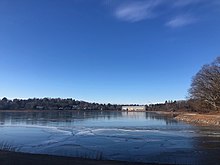
Summary
Chestnut Hill Reservoir is a reservoir located in the Chestnut Hill section of Boston, Massachusetts. It was created in 1870 on existing marshes and meadowland to supplement the city’s water needs. A 1.56 mile[1] jogging loop abuts the reservoir. Chestnut Hill Reservoir was taken offline in 1978 as it was no longer needed for regular water supply distribution,[2] but is maintained in emergency backup status.[3][4] It is recognized today on the National Register of Historic Places and was designated as a Boston Landmark by the Boston Landmarks Commission in 1989.

| Chestnut Hill Reservoir | |
|---|---|
 View of Gasson Hall (Boston College) from across the reservoir | |
 Chestnut Hill Reservoir  Chestnut Hill Reservoir | |
| Location | Chestnut Hill, Boston, Massachusetts |
| Coordinates | 42°20′6.30″N 71°9′30.52″W / 42.3350833°N 71.1584778°W |
| Type | reservoir |
| Basin countries | United States |
On May 1, 2010, the Chestnut Hill Reservoir was temporarily brought back online during a failure of a connecting pipe at the end of the MetroWest Water Supply Tunnel. The Sudbury aqueduct was also activated to feed Chestnut Hill from the Foss and Sudbury reservoirs to keep the supply going. Separately the Spot Pond reservoir, also an emergency source, was tapped during the pipe break incident. Though a boil-water order was issued for fear that the water would not be safe to drink, following heavy treatment with chlorine later tests showed the water to be completely safe for drinking.[5][6]

Transportation edit
- Reservoir, Green Line (D) (MBTA)
- Cleveland Circle, Green Line (C) (MBTA)
- Chestnut Hill Avenue, Green Line (B) (MBTA)
See also edit
References edit
- ^ Water For Greater Boston Brighton Allston Historical Society. See paragraph 9.
- ^ "MWRA history". Retrieved 2012-06-16.
- ^ Massachusetts Water Resources Authority (May 4, 2009). "Water Supply and Demand". Retrieved 2009-08-16.
- ^ Massachusetts Water Resources Authority (August 9, 2006). "Water System History". Retrieved 2009-08-16.
Completion to the Dorchester Tunnel in 1978 allowed the demands of the southern systems to be removed from the Sudbury Aqueduct. However, because there is no redundancy for the Dorchester Tunnel, the facilities taken off line in 1978 must remain in stand-by status.
- ^ Daley, Beth; Gil, Gideon (May 5, 2010). "Tests confirm it — water was OK to drink all weekend". The Boston Globe.
- ^ "Water Piping Repairs 'Holding Great,' Says MWRA Director".
External links edit
- U.S. Geological Survey Geographic Names Information System: Chestnut Hill Reservoir
- Chestnut Hill Reservation History at the Department of Conservation and Recreation
- Newton Conservators


